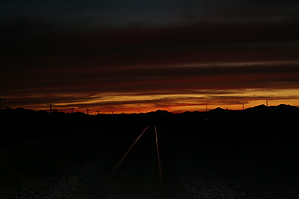| Guide | ♦ | 17 Triplogs | 0 Topics |
details | drive | no permit | forecast | route |
stats |
photos | triplogs | topics | location |
| 134 | 17 | 0 |
Trainspotting! by Randal_Schulhauser  Some History Some HistoryIn 1850, James Gadsden, president of the South Carolina Railroad Company, dreamed of a southern transcontinental railroad to California, linking the West directly with the Southern states. The best route lay south of the new U.S. border. This prompted the "Gadsden Purchase," in which the Mexican government was paid $10M for a strip of land south of the Gila River. Gadsden didn't live to see the line built, but Central Pacific president Colis Huntington saw the route's value. He ordered his Southern Pacific Railroad to begin building east from Los Angeles in 1877, with rails reaching Tucson in March, 1880 and then El Paso in May, 1881. It was quickly dubbed the "Sunset Route", and the Southern Pacific circular logo showing a setting sun over a railroad track became the company's trademark. Southern Pacific's premier passenger train on the route was named the "Sunset Limited." Copper deposits in Southern Arizona comprised most of the initial traffic, but by the mid-1890s, affluent vacationers filled the passenger trains destined for winter resorts in Tucson, Phoenix, and Pasadena. Vegetables grown in California's Imperial Valley soon became an important commodity. Southern Pacific ran the first refrigerator trains loaded with produce from the valley in 1884. As growing freight traffic created longer and heavier trains, the steady 1% grade up out of the Gila Valley and through the Maricopa Mountains required "pusher" locomotives to assist trains through the pass. A series of "Y-spurs" off the mainline allowed the engines to turn-around and get behind the next train. The small community of Shawmut soon sprouted to service these "pusher" locomotives. You can locate the abandoned roadbeds of some of the "Y-spurs" where Maricopa Road juts away from the existing rail line.
Today's rail traffic looks very different from that past era with double-decker containers from the Pacific Rim, creating more and more congestion along the Sunset Route. Less than one-quarter of the Sunset Route was double-track when Union Pacific acquired it in 1996 as part of the merger with Southern Pacific. Since then, Union Pacific has built more than 100 miles of new mainline double-track. The ultimate goal is to double-track the entire route, but the 1% grade through the Maricopa Mountains near Shawmut's abandoned settlement remains mostly single-track. This congested area creates a trainspotter's delight! You'll notice that Maricopa Road near Shawmut is sponsored by "Arizona Railfans" and "Arizona Rail History Buffs,"... a testament to its esteemed trainspotter status. The Hike Shawmut is surrounded on all sides by the Sonoran Desert National Monument. The Maricopa Mountains naturally part here, funneling traffic through the pass. This mountain pass and nearby Butterfield Pass have been leveraged throughout the centuries as a significant transportation route. From the turn-out along Maricopa Road, park your vehicle. Any doubt about your location is removed by the signage on the railway signals. Respect the railroad right-of-way and use the bridged wash to pass under the railway tracks to the south side. Immediately to the south is a small mountain with a ridgeline providing a fine vista for trainspotting. There is no discernable trail along the ridgeline, but the route is obvious. As you look to the east, the double-track sharp S-curve dominates the view. Although rail traffic is heavy along this route, there was a disappointing lull while I was up on the ridgeline. With the sun beginning to set and me unable to snap a photo of a train within the S-curve, I've used an Arizona Railfans stock photo to convey the image. Guess I have a reason for a return hike! As you scramble east along the ridgeline, it will suddenly drop down into a wash. Follow the wash back to the rail bridge completing the loop hike. As I crossed under the rail bridge I could hear an approaching train. That's a great way to end a trainspotting hike! Summary: Although this may not be considered a hike in the classic sense, I welcome variety in my outdoor adventures. I find this hike a curious contrast with transportation technology, the focal point. Still, you are standing within a national monument with a wilderness area to the immediate north and south. There seems to be a constant affinity between boys and trains, and I don't think I've ever lost it... Enjoy! Check out the Official Route and Triplogs. Leave No Trace and +Add a Triplog after your hike to support this local community. | ||||||||||||||||||||||||||||||||||||||||||||||||||||||||||||||||||||||||||||||||||||||||||||||||||||||||||||||||||||||||||||||||||||||||||||||||||||||||||||||||||||||||||||||||
 Route Editor
Route Editor




